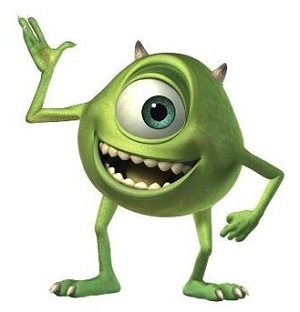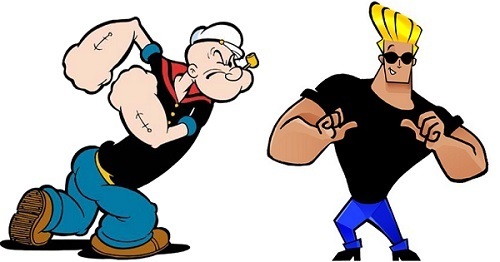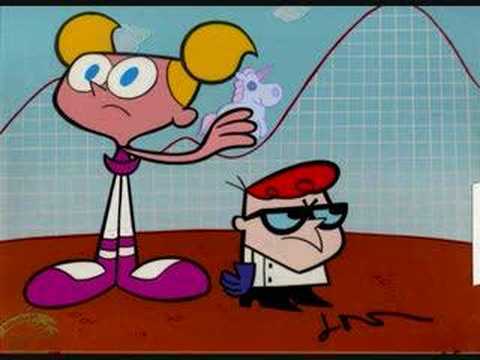6 Unintended Consequences Of Cartoon Character Design

Most animated characters look the way they do for a plethora of boring reasons, like being easier to identify, a more attractive appearance, or just plain freaking the shit out of children. But the illustrators and animators don't usually take into account the weird side effects which would befall their creations if they were real. I do, though, because I'm paid to think about weird shit.
Four Fingers Would Lead To Weird Numbers

Many cartoon characters have four digits per hand instead of the five we have, because four fingers are far easier to animate than five and actually look less weird and crowded when the character is holding or manipulating something.

But there would be an unintended consequence of evolving only eight fingers. Any such cartoon civilization would have an octal system of counting, or base eight. This means that the fictional worlds in which they lived would be ruled by completely different numbers than our own.
Important values would be based on powers of eight, so that the octal number ten would represent eight in decimal. 100 would be 8x8, or 64. 1,000 would be 8x8x8, or 512. This would lead to some really bizarre math for any human unfortunate enough to cross over into 2D four-fingered land, and those scores in Space Jam would make no damned sense to Jordan.

Those important numbers would be most evident in the screwy way they would measure time. The year 2014 in our world becomes 3736 in base 8 in Toon Town, since the equivalent of a century has 64 years, and the equivalent of a millennium just 512. The base eight year 3000 happened in our base ten year of 1536, and the octal world's next millennium at the year 4000 will be coming up in our year 2048. The same amount of time will have passed; it's just represented by different digits.
Then there's the money. As Andy Kiersz of Business Insider says: "One dollar in base ten would convert over to $1.44 in base eight, and $0.84 in base twelve. Conversely, what we'd call a dollar in our world with eight fingers -- $1.00 in base eight -- would translate to just $0.64 in our base ten world." So any intra-world trading going down in Who Framed Roger Rabbit? would be fraught with the kinds of difficulties that would make our stock exchange look like an abacus.

The most interesting thing would be the fact that base eight would make it far easier for the 'toons to read binary, since any three-digit 0/1 sequence can be broken down into multiples of two, whereas we struggle because of our shitty extra fingers. That means there's a very real possibility that these characters would have invented computers way earlier than our base ten selves. Which might go some way to explaining the quantum tunneling technology in Monsters, Inc., or how the Roadrunner is able to break the fourth wall and escape all of Wile E. Coyote's traps.
Bigger Eyes Means Way Better Vision

Most good characters have big eyes to make us care for them, fall in love with them, or sob uncontrollably when they die (damn you, Bambi). But those giant-ass pupils would also allow in a crapload more light than ours, meaning they will have far better night vision than we do. Any situation in which a bug-eyed Disney princess is stuck in utter darkness wouldn't actually be that bad, as they basically have cat vision. And it'd help any monsters working at Monsters, Inc. when they're sneaking into children's bedrooms at night to scare the piss out of them. Bigger eyes would also mean these characters could see much farther into the distance than us, discerning tiny shapes from vast distances away, like an even more femininely attractive version of Legolas.
This applies right across the board, from the Powerpuff Girls to Bing, from Rapunzel in Tangled to every anime character ever. Those giant honestly-I'm-not-high pupils make every adorable cartoon character a freakin' superhero.
The best example is Mike Wazowski from Monsters, Inc./University. He is essentially an eye with limbs.

Assuming the diameter of his eye is about a foot, this means that his pupil would be about seven centimeters wide. Using the most important equation in astronomy, we can calculate the angular resolution of Mikey's eye. In real-world terms, it means he could read your name badge from miles away.
Of course, this means their brains would use way more processing power for their vision -- the same problem which might have caused the extinction of the Neanderthals. But hey, nobody's perfect.
On the other hand, any animated characters that are much smaller than we are but have the same giant eyes we know and love will struggle to see anything any real distance away. So all the ants in Antz and A Bug's Life (who, in our world, have compound / non-cantaloupe-sized eyes for this very reason) would struggle to see anything in focus, because the wavelength of light isn't small enough when you get down to bug height. Basically, real ants would kick the shit out of the ants from Antz. Yes, even Sylvester Stallone's character.

Additionally, an overwhelming number of cartoon characters in shows like The Simpsons, Family Guy, South Park, Scooby-Doo, Adventure Time, and Looney Tunes do not have irises -- only a pupil in the center of a vast cornea. This is a problem, because the iris isn't just there to look pretty; it is a muscle tissue which allows us to expand or contract the size of the pupil. Without this, these characters would not be able to regulate how much light reaches the retina, and therefore would struggle to see anything in very bright or very dark environments.
Huge Heads And No Hips Lead To Maternal Death

Just like big eyes, big heads are cute and make us go awwwwww. Well, up to a certain point. Proportionally speaking, humans have the biggest heads of the animal kingdom. Taking into account our encephalization quotient (EQ -- head size in relation to the body's size) of 7.5, compared with dolphins at 5.3 and a mouse at 0.5, it's clear that the bigger the brain, the better.
It may mean that we're really smart (well, up to a certain point), but it also means that we have to be born far sooner than other mammals. Otherwise, our giant skulls would kill our mothers during childbirth.
Many of the characters with giant heads must have either been born at a very early stage of development (which comes with risks for the baby) via a cartoon version of a c-section (I'm thinking maybe a zip in the stomach), or just flat-out killed their mothers on the way out.

But even giving birth to normal-headed babies, cartoon mothers would almost certainly have problems during childbirth. Just look at the slew of wasp-waisted female characters there are out there. Many of the animators don't seem to understand that women have rib cages, hips, or, fuck it, skeletons. It may look "more elegant" or sexier, but many of those girls wouldn't survive their second trimester, let alone pushing a baby out.

Either there must be a huge demand for cesareans in cartoon hospitals, or it goes some way to explaining why so many Disney princesses have evil stepmothers: Their hourglass-figured moms died giving birth to them.

Top-Heavy Guys Evolved Differently

A lot of male characters have huge upper bodies compared to their lower halves. This is simply to show off how muscular and strong they are. By accentuating the biceps and minimizing the leg-ceps (that's a thing, right?) animators can show kids instantly that a guy is going to punch the baddie through the wall. Popeye and Johnny Bravo are two good examples of this.

But there are some serious structural problems here. They simply don't have the legs to support their own weight. Of the five strongest muscles in our bodies, two of them are for our legs (gluteus maximus and soleus, respectively). They need to be, as they have to hold us up all day, but looking at many of these characters, their legs would snap under the immense weight of their upper bodies.
Having far shorter legs would lead to issues as well, like climbing stairs, seeing where their feet are, and (duh) running. Let's assume for argument's sake that their legs could support their weight. They still wouldn't have been able to run well enough to not be eaten. In our world, what with lions and shit trying to eat us when we came down from the trees, the faster we could run, the better.
Shorter legs mean that, in those cartoon worlds, the characters' ancestors must have had an evolutionary advantage over those with longer legs. Cavemen Popeye and Johnny Bravo either stood their ground and beat the shit out of said lions, or stayed in the trees much longer than ours did, giving them the long arms / short legs gorilla/orangutan look.
Too much muscle leads to another problem: maneuverability. Giant pectorals, huge shoulders, and massive biceps might make you look big and intimidating, but it means you can't really turn or bend. Or, more importantly (if you're into personal hygiene), wipe your ass. There would be so many everyday situations in which these guys couldn't do basic activities we take for granted because their bodies would get in the way.

Kronk from The Emperor's New Groove even acknowledges this: "I should tell you right now, I'm kind of hard to fit. I wear a 66 long and a 31 waist." Pants shopping should not be that much of a nightmare for anyone.
Short Or Thin Limbs Are A Disaster

Look at Stewie Griffin again. His head, as we've discussed, is ridiculously large (though it may explain his increased intelligence and tendency toward plotting world domination). Now look at his arms. What does he do if he has something in his ear or his eye? His arms are too small to reach.

The same goes for the Bing! and Rugrats characters.

None of them, not even the weird sentient plushies that are tasked with looking after the kids in Bing!, can reach their own ears or the tops of their own heads. Washing their hair would be impossible. They would either have to ask someone else to help or bring special tools into the shower.
It's a good thing Totoro can fly, because those arms and legs would have him starving to death otherwise. If you can't reach your own mouth, you either need to have some very close friends you trust implicitly, or you'd better lie down, give up, and let natural selection take its course.

Betty Boop, Ted, Pikachu, and the Minions all have short arms that would make it difficult for them to survive on their own. Their ancestors (if they had any) would have struggled to groom or feed themselves, and would therefore have had to stay in groups to get by.
Dexter's Laboratory has two vastly different examples of extreme limb problems: the eponymous Dexter and his sister Dee Dee.

Dexter is so short in stature and his arms and legs are so utterly useless that it's extremely lucky he's a goddamn genius. He can create machines/tools to help him feed himself and reach things he needs (though why he made the worktops in his lab so high is beyond me). Dee Dee, by comparison, is all limbs. In reality, her arms and legs would simply snap off if they encountered any sizable weight/force.
For us to be able to lift things (including our own bodies) we need muscles. For even the simplest of movements, calculations of load, effort, force, and torque decide how much our limbs can lift. This gets ridiculously complex if there is a multi-joint movement involved. This means that if any of the following characters were to make it to our world (as we see many others do in crossovers, specials, shorts, and one-offs), they wouldn't even be able to sit up: the Shadow Man from The Princess And The Frog, Courage the Cowardly Dog, Olive Oyl, Mirage from The Incredibles, Jack Skellington, and Sonic the Hedgehog, to name just a few.

So what can we assume is different where they live (apart from the fact that they're fictional and, in many cases, two-dimensional)? Gravity. This would explain how they haven't snapped in half every time they get out of bed in the morning, and also some of the batshit-crazy jumps and spins we see them do. If the gravity on their planets was a mere fraction of our own, they could jump like an astronaut on the moon and would require a much smaller muscle mass.
Of course, crossing over to our Earth would instantly flatten them like an animated pancake.
Not Having Lips Creates A Lot Of Problems

Lips are another part of the body we don't think about very often that have actually determined a huge amount of our evolution. First off, there's breastfeeding. An absolutely essential part of our upbringing (especially before formula), the sucking reflex that we are all born with is a hard-won evolutionary impulse which is activated when something brushes against the new-born's lips. After that, lips are a big part of how we navigate the world -- it's why toddlers are always sucking and wedging random stuff in their stupid, chocolaty faces.
Compare that with the characters on South Park. How do they suck? Can they whistle? Drink Coke through a straw? Not in our world, they couldn't. To do so, they would need lips. Then there are the characters on The Simpsons, Family Guy, Mickey Mouse Clubhouse, Looney Tunes, Charlie Brown, The Flintstones, Dora the Explorer, or anything by Studio Ghibli.

Neurologically, being lipless would make even the most human-like characters very different from us. Our brains take in different amounts of information from our touch sense, depending on the part of the body it comes from. The lips relay a huge amount. So characters without them must be receiving more information from different parts of their bodies, completely changing how they react to stimuli.
There's another major social activity that these characters wouldn't be able to engage in properly in our world: kissing. Sure, Homer and Marge kiss often, for example, but they wouldn't be able to here. But there is an interesting possibility, as not all human cultures engage in kissing.
In cultures without kissing, "sex partners may blow in each other's faces, lick, suck, or rub their partner's face prior to intercourse." The "Eskimo kiss" we all make fun of isn't actually about rubbing noses, but about sniffing -- exchanging scents. It's possible that the act of kissing could have come along as an enjoyable means for sniffing out possible romantic partners in these cultures. So these cartoons might also have developed a heightened sense of smell to compensate for the lack of kissing, and as a way to get laid.
This would mean that other parts of the brain devoted to smell would be bigger and more complex than that of touch. Maybe that's why so many of them have giant noses.

Then there is the basic issue of speech. Many of the sounds that we make involve the use of our lips. By bringing our top and bottom lips together we can form the sounds p, b, and m. To make the sounds f or v, we bring our lower lip to our upper teeth. Moving the back of our tongue to the roof of our mouth while also moving our lips closer together makes a w sound. Which means, without lips, these characters would not be able to pronounce a fifth of our alphabet.
And don't even get me started on eating spaghetti.

Now, I get it. They're only cartoons; they're not real. But by simplifying the designs down to dots for eyes and lines for mouths, it means that if they ever stumble into our reality (you know, in a Stephen King / Treehouse of Horror sorta way), their creators have all but guaranteed them a confusing, painful hellscape.
Zoroastrianism used to be one of the biggest religions in the world, but their idea of heaven had a slight twist on it: to get there you'd have to cross a bridge. Sometimes rickety, sometimes wide and sturdy, if you fell off you'd go to the House of Lies for eternity. Fun! Not terrifying at all! This month, Jack, Dan, and Michael along with comedians Casey Jane Ellison and Ramin Nazer as they discuss their favorite afterlife scenarios from movies, sci-fi and lesser-known religions. Get your tickets here and we'll see you on the other side of the bridge!
See the darkest side of cartoons in 7 Horrifying Things Snuck Into Famous Children's Cartoons and find out why certain religions hate Spongebob in 7 Things From Pop Culture That Apparently Piss Jesus Off.
Subscribe to our YouTube channel to see the truth behind the Ninja Turtles in The Greatest Ninja Turtles Fan Theory You've Ever Heard!, and watch other videos you won't see on the site!
Also follow us on Facebook because sometimes flaming us in the comments section just isn't enough.





